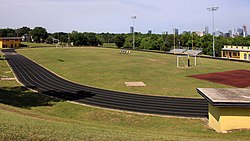Anderson Stadium
 Viewed from the slope to the northeast | |
 | |
| Address | Austin, Texas United States |
|---|---|
| Type | Stadium |
| Acreage | 7 acres (2.8 ha) |
| Construction | |
| Built | 1953 |
| Renovated | 1993–1994 |
Anderson Stadium | |
| Coordinates | 30°16′12″N 97°42′36″W / 30.270°N 97.710°W |
| NRHP reference No. | 100007202[1] |
| Added to NRHP | February 3, 2022 |
Anderson Stadium, also known as Yellow Jacket Stadium, is a historic
History
After the publication of the
Anderson Stadium, also known as Yellow Jacket Stadium (after the Anderson High School
In the late 1960s, the federal
In 1993, Anderson alumnus and former National Football League player Thomas Henderson proposed to restore Anderson Stadium so that it could be used as a community center. Donations and volunteer work in the 1990s drove the restoration of the grass field and the replacement of the running track, goal posts, and scoreboard. New bleachers, high-mast lighting, and a concession and restroom building were also added. Further improvements in the 2000s and 2010s include an enlarged concession and restroom building, an improved running track, and a new fieldhouse. In 2021, the campus was reopened as the site of Eastside High School.[5]: 9–10
Anderson Stadium was listed on the National Register of Historic Places on February 3, 2022, in recognition of its historical significance as the last extant high school football stadium in Texas constructed exclusively for African Americans, as well as its importance as a shared event space for the East Austin black community.[5]: 14
Design

Anderson Stadium is a typical high school football and track facility, with a level grass playing field, oriented north-to-south, surrounded by an oval running track (originally of sand and dirt, but now surfaced in rubber).[5]: 11–12 It sits in a slight depression in the surrounding topography, surrounded by a natural bowl-like landform whose slopes have served as additional seating space for large crowds.[5]: 7 The field and track are flanked by the original two-story concrete fieldhouse and one-story concrete concession stand, along with a newer fieldhouse, concession stand, goal posts, high-mast lights, and scoreboard dating to the renovations of the 1990s. The original wooden bleachers have likewise been replaced with newer metal seating.[5]: 11 The historic buildings are utilitarian and rectangular in design, built as simple concrete blocks, a reflection of the inferior investment made in a site intended for black students.[5]: 12
See also
References
- ^ "National Register Information System – Anderson Stadium (#100007405)". National Register of Historic Places. National Park Service. November 2, 2013.
- ^ Craver, Jack (March 20, 2018). "City leaders discuss legacy of segregation from 1928 plan". Austin Monitor. Archived from the original on March 10, 2021. Retrieved March 26, 2021.
- ^ Thompson, Ben (September 24, 2021). "East Austin university and high school stadium, Allandale 'air-conditioned village' move toward national historic recognition". Community Impact Newspaper. Archived from the original on February 7, 2022. Retrieved February 7, 2022.
- ^ a b Saldaña, Sean (September 13, 2021). "East Austin stadium celebrated by Black community nominated for national historic status". Austin Monitor. Archived from the original on February 7, 2022. Retrieved February 7, 2022.
- ^ a b c d e f g h i j "National Register of Historic Places Registration Form" (PDF). Texas Historic Sites Atlas. Texas Historical Commission. Retrieved August 26, 2022.
- ^ Dobrasko, Rebekah (July 21, 2021). "Losing a Community Catalyst: The Closure of L.C. Anderson High School". Preservation Austin. Archived from the original on February 14, 2022. Retrieved February 14, 2022.


